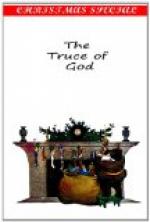But society had to protect itself. Conscious of its danger, and that it was doomed to destruction, if some remedy were not found, it evolved in the tenth and the following century, not an absolutely efficacious remedy, but one which enabled it to pass in comparative safety that dangerous period and carried European civilization to the full glories of the age of Dante, St. Louis and the Angel of the Schools. The remedy was feudalism.
That institution has been misunderstood. It was called forth by special needs, and when the conditions which it met in an almost providential manner changed, it quietly passed away. But it rendered an important and never-to-be forgotten service to war-torn Europe. Feudalism can scarcely be called a complete and rounded system. For it was constantly undergoing modification. It was not the same north as south of the Loire. It was one thing on the west, and quite another on the east of the Rhine. In general it was, as Stubbs described it ("Constitutional History.” Vol. 1, pp. 255, 256), “a regulated and fairly well graduated method of jurisdiction, based on land tenure, in which every lord, king, duke, earl or baron protected, judged, ruled, taxed the class next below him; ... in which private war, private coinage and private prisons took the place of the imperial institutions of power.” Land, “the sacramental tie” then, “of all relations,” and not money, was the chief wealth of those ages. For services rendered, therefore, fiefs or landed estates were the reward. Feudalism thus rested on a contract entered into by the nation represented by the king, which let out its lands to individuals who paid the rent not only by doing military service, but by rendering such services to the king as the king’s courts might require. The bond was frequently extremely loose, and it was hard then to say which of the two was in reality the stronger, the feudal lord or the technically lower, but sometimes in reality stronger, vassal.
The feudal lord was bound to support his vassal, and in return, had a right to expect his help in the hour of danger. The feudal lord owed his vassals justice, protection, shelter and refuge. If certain privileges, claimed by the feudal lord, were onerous, the vassal was not without some guarantee that he would be shown fair play; for it was evident that unless in some way rights and obligations were fairly well balanced, and there was a fair return for service rendered, the whole system would soon crumble to pieces.
The “system,” if it can be called one, was, as we have said, by no means perfect, but it bridged the historic gap which stretches between the fall of the Carolingian power and the full dawn of the Middle Ages. It saved Europe from anarchy. Its blessings cannot be denied. It helped to foster the love of independence, of self-government, of local institutions, of communal and municipal freedom. The vassal that lived under the shadows of the strong




